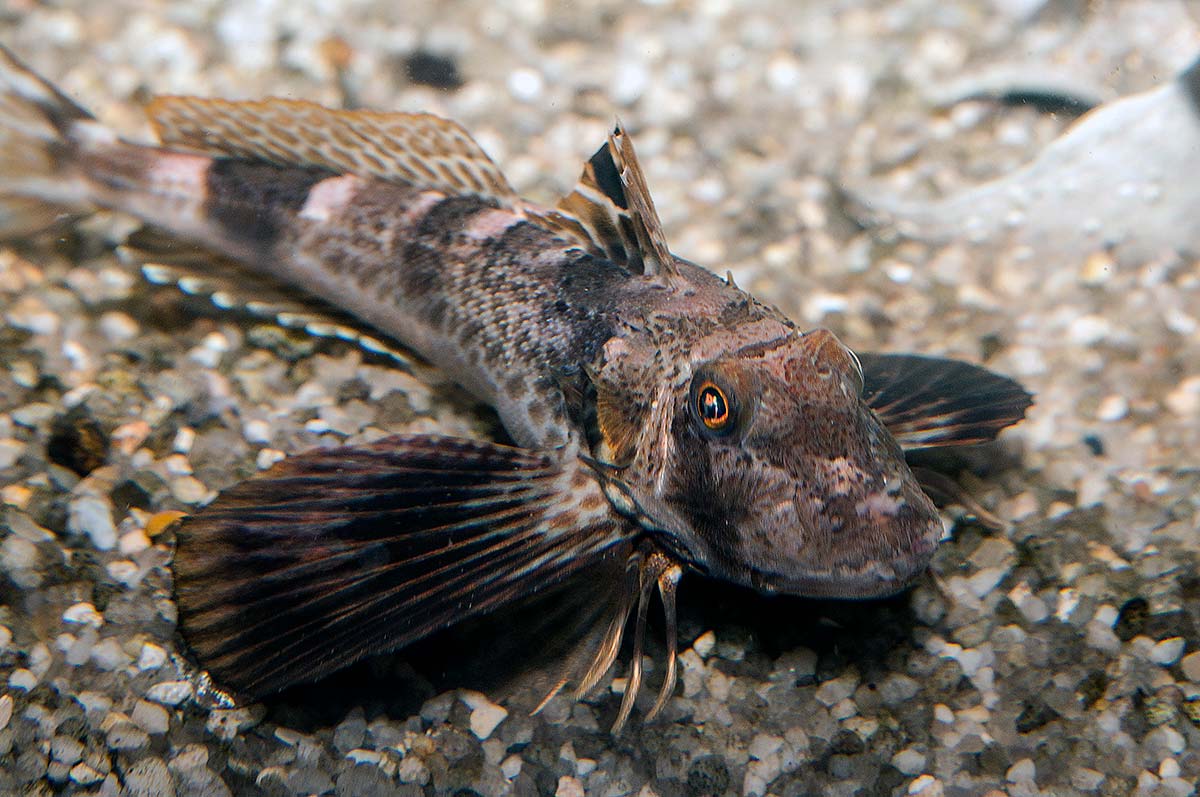
A common bottom-dweller in the Northeast that you will find almost all season long.
The northern sea robin is also known as the common sea robin. They are found from Nova Scotia, south to Florida, and into the Gulf of Mexico. Its coloration is made up of red, grey, and brown, with dark blotches along its back. The bottom of the fish is a dirty white or pale yellow. This species usually grows to a length between 12 to 16 inches, but larger specimens are not out of the question. They prefer a smooth, hard-packed bottom in an open bay but can be found inside harbors, back estuaries, and even the open ocean.
It’s very easy to identify the northern sea robin from the striped sea robin. The northern has a large, bulbous, spiny head and body that tapers down to the tail. They have rounded, fan-like pectoral fins that are very large and extend horizontally like airplane wings. The three lower rays of the northern sea robin’s pectoral fins are long, crab-like leg feelers used to walk along the seafloor and find food on the bottom. The front portion of the head of the northern sea robin and most other sea robins have bony plates, which they use as a shovel to dig up different types of invertebrate foods from the bottom to eat. There is a small spine in its nose. The northern sea robin’s eyes have a peacock blue coloration. These features help identify this species from a similar shaped and looking fish—the sculpin.
Northern sea robins are usually found swimming in areas of hard to smooth bottom types but are not typically seen by scuba divers on rocks or in the mud. These fish constantly swim along the bottom in search of food. They will bury themselves in the sand when threatened, showing only their eyes and the top of their head.
The northern sea robin will eat a wide variety of invertebrates, including squid, crabs, shrimp, amphipods, segmented worms, and mollusks. They’re known to take a bite from any bait an angler presents, and it’s not out of the question to hook one on a lure, giving the impression they are not picky eaters. Since they are well-known bait thieves, this species is considered to be a nuisance to fishermen. Some anglers find these bottom-dwellers as a worthy table fare and harvest them while targeting another species.

The striped sea robin is found in the western Atlantic from Nova Scotia south to Florida, however, it is a rare find north of Cape Cod. I have never seen or photographed this species anywhere north of the Cape Cod Canal in my years of underwater photography. This species is easy to tell apart from the northern sea robin because they have horizontal black stripes that run the entire length of the body from just behind the gill plate back to the tail. Other than the difference in coloration and pattern along with bodies, they look pretty similar in size and shape to the northern sea robin.
The striped species is usually found on sandy bottoms within estuaries and nearshore waters down to 590-foot depths. Like many species found along the East Coast, the striped sea robin spawns in late spring through summer and migrates into deeper waters and southward during the winter months. Their large fan-like pectoral fins are used to soar over the bottom and churn up sediment in order to find prey. This species reaches maturity by the time they are two to three years old.
Sea robins are well known for their voices. Various sounds have been documented, including clucks, growls, and clicks. Little is known about why these fish make such a noise. The strange sound has been observed more commonly during the spawning season and is believed to be related to the spawning act. Sea robins, in general, have a very large swim bladder that vibrates using a combination of muscles and fiber-like attachments.
Neither the states nor federal government manage sea robins, and their populations or fishery landings data are not monitored. Sea robins are not traditionally harvested or marketed by charter and party boats. The abundance data on sea robins are recorded by ongoing state surveys of estuarine fish communities.



